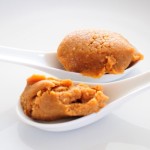
This ancient fungus appears in countless East Asian fermentation practices: It’s the “starter” used to ferment miso, soy sauce, sake, rice vinegar, and shōchū. No matter what type of miso you’re dealing with, it all starts with a mold spore called Aspergillus oryzae, also known as koji. Accordingly, wealthier merchants could afford to purchase more expensive miso made with rice, whereas farmers and townsfolk often ate miso made with millet, barley, or other common grains. “Traditionally, rice miso is more expensive than barley miso, because the grain is more expensive,” explains Chung. The emergence of a wealthy merchant class in major Japanese cities like Kyoto and Edo (now called Tokyo) led to an increase in demand for high-grade miso. Still, class stratifications remained apparent in the trade and purchasing of miso.

The onset of the 17th century brought about the industrial production of miso, propelling the nutrient-dense soybean paste to widespread popularity. Today, rice and miso soup remain a popular Japanese breakfast. In the 12th century, miso soup-which used a small amount of the precious paste to flavor dashi, a Japanese broth-became a dietary staple of Kamakura samurai. At first, miso was considered a delicacy, only available to Japanese nobility and monks-they ate the fermented paste either as a spread or on its own. According to the Japan Miso Promotion Board, miso was first introduced in Japan in the 7th century.

Though miso has become emblematic of Japanese cuisine, the ingredient is believed to have originated in China or Korea. It’s a vital ingredient in Japanese cooking, often used to bring a wallop of savory flavor to soups (like miso soup and hot pot), noodles, and yakitori dishes. In fact, over 1,300 variations of the umami-rich paste are in use today. Factors like the type of koji used and the length of fermentation can result in infinite varieties of miso, including some that contain no soybeans at all (more on that below). Miso, a.k.a. fermented soybean paste, is made by combining just three simple ingredients-soybeans, salt, and koji (a type of fungus cultivated on rice and other grains)-and allowing the mixture to age for months or even years. But before we dive into all the kinds of miso you may spot at the supermarket, let’s start with the basics. But what is miso exactly? And how can you incorporate it into your own cooking routine? Below, we’ll guide you through a few of the many, many varieties of miso available around the world and talk about a few of our favorite ways to use each one. In recent years, the fermented staple has grown in popularity across the globe, dressing tangles of glossy spaghetti and adding nuanced flavor to baked goods. Miso rarely goes bad, but recommended to consume in 6 months to 1 year time.For centuries, miso has claimed a central spot in the Japanese culinary canon. Soybeans (Non-GMO from Kenya), Rice (from Kenya), Rice malt "Koji" (from Japan), Salt Don't be afraid of using miso for anything, not limited to Asian food! Even in pasta, mushroom sauce, scrambled eggs. You can also add some soy sauce to taste.Ĥ. This mixture is also available as "All Purpose Miso Sauce" at Alphajiri ! Vegetable stir-fry and marination for meat- We introduce here a recommended ratio of miso sauce Miso 1 cup : Mirin (Rice Wine) 1cup : Sake 1/2 cup: Sugar 2 tbsp. It's also a good idea to add some some ground roasted sesame, pepper, or other spices you like!ģ. Vegetable dip - mix miso and mayonnaise in the ratio of 1 to 2. Miso soup can be used as noodle soup, such as ramen, soba, udon, and rice noodles! Some noodle soups can be more creative with coconut milk, peanut butter, and gochujang paste!Ģ. Some examples working well as broth are fresh shiitake mushrooms, vegetable / chicken / beef bouillon cubes, and fresh chicken / pork /fish. Miso Soup - Traditional miso soup is made up of miso, broth, and other ingredients. The paramount of miso is "umami," the essence of deliciousness that comes from glutamic acid.īut white is much sweeter and less salty than brown one.ġ.

Soybean : Kome koji (malted rice) ratio - Brown : 1 to 1 / White 1 to 2īoth brown and white miso have pleasant savoury flavour. But the biggest difference is the ratio of the ingredients. Ours are handmade using locally sourced soybeans and Koshihikari rice.Ĭarefully peeling soybean cover and sieve the paste with a fine mesh for finishing,īrown colored miso is more widely known, but basically white miso's ingredients are just the same as brown one - soybeans, malted rice (called "Kome Koji"), and salt. We are the first company that manufactures white miso in Kenya.!


 0 kommentar(er)
0 kommentar(er)
